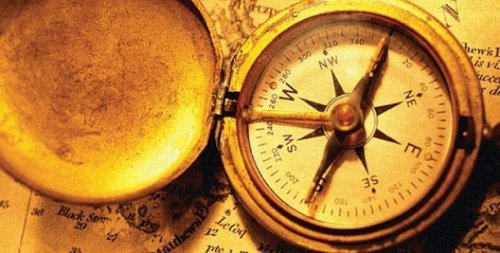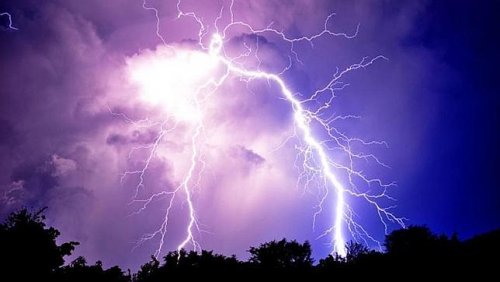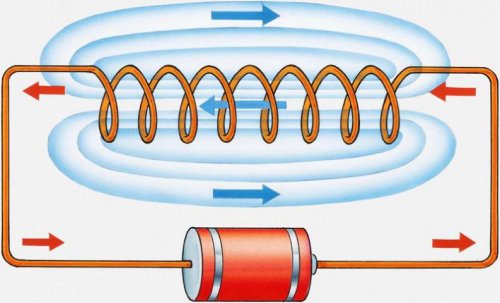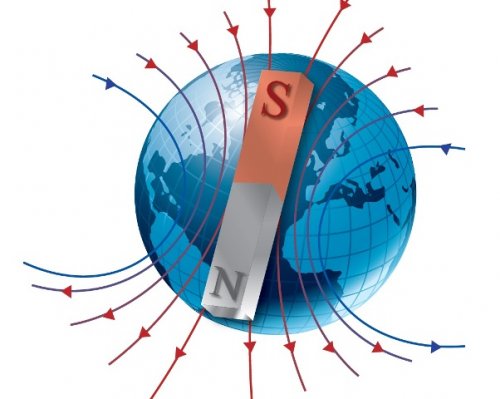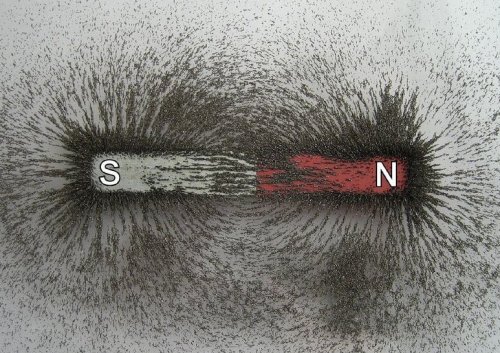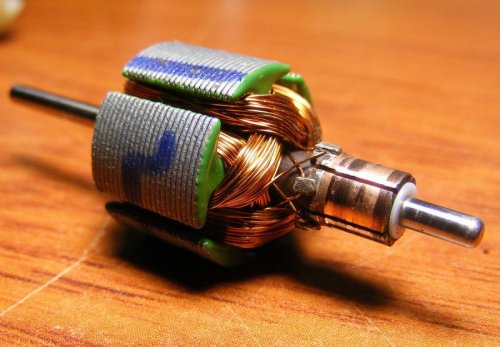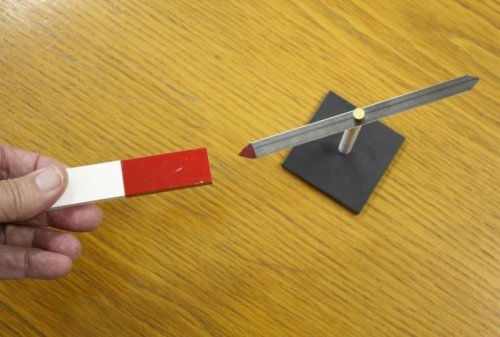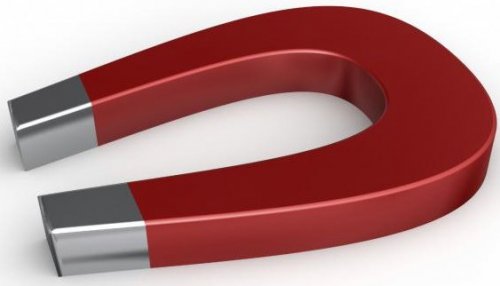Magnetic phenomena in physics - history, examples and interesting facts
Magnetism and electricity
The first practical application of the magnet was in the form of a piece of magnetized steel floating on a plug in water or oil. In this case, one end of the magnet always points north and the other south. It was the first compass used by sailors.
Just as long ago, several centuries before our era, people knew that a resinous substance — amber, if rubbed with wool, received for a while the ability to attract light objects: pieces of paper, pieces of thread, fluff. This phenomenon is called electrical ("electron" means "amber" in Greek). Later it was noticed that electrified by friction can not only amber, but also other substances: glass, wax stick, etc.
For a long time, people did not see any connection between two unusual natural phenomena — magnetism and electricity. Only an external sign seemed to be common—the property of attracting: a magnet attracts iron, and a glass rod rubbed with wool scraps of paper.True, the magnet acted constantly and the electrified object loses its properties after a while, but both "attract".
But now, at the end of the 17th century, it was noticed that lightning — an electrical phenomenon — striking near steel objects can magnetize them. Thus, for example, once steel knives lying in a wooden box turned out to be magnetized to the indescribable surprise of the owner, after lightning struck the box and broke it.
Over time, more and more such cases are observed. However, this still does not give reason to think that there is a strong connection between electricity and magnetism. Such a connection was established only about 180 years ago. It was then observed that the magnetic needle of the compass deviates as soon as a wire is placed near it, along which an electric current flows.
Almost at the same time, scientists discovered another, no less striking phenomenon. It turned out that the wire through which the electric current flows is able to attract small iron shavings to itself. However, it was worth stopping the current in the wire, because the sawdust immediately fell apart and the wire lost its magnetic properties.
Finally, another property of electric current was discovered, which finally confirmed the connection between electricity and magnetism. It turned out that a steel needle placed in the middle of a wire coil through which an electric current flows (such a coil is called solenoid) is magnetized in the same way as if rubbed with a natural magnet.
Electromagnets and their use
From experience with a steel needle and was born electromagnet… By placing a soft iron rod in the middle of the wire coil instead of a needle, scientists were convinced that when a current passes through the coil, the iron acquires the property of a magnet, and when the current stops, it loses this property. At the same time, it was noticed that the more turns of the wire in the solenoid, the stronger the electromagnet.
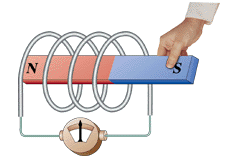
Under the influence of a moving magnet, an electric current is generated in the wire coil
At first, the electromagnet seemed to many just a funny physical device. People did not suspect that in the near future it would find the widest application, serve as the basis for many devices and machines (see — Practical application of the phenomenon of electromagnetic induction).
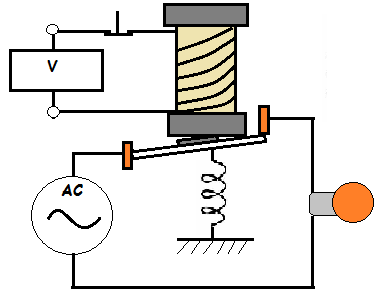
The principle of operation of the electromagnetic relay
After it was established that an electric current gives a wire magnetic properties, scientists asked the question: is there an inverse relationship between electricity and magnetism? For example, would a strong magnet placed inside a coil of wire cause an electric current to flow through that coil?
In fact, if an electric current appeared in a wire under the action of a stationary magnet, this would be completely contradictory law of conservation of energy… According to this law, in order to obtain an electric current, it is necessary to expend other energy that would be converted into electrical energy. When an electric current is produced with the help of a magnet, the energy expended in the movement of the magnet is converted into electrical energy.
Study of magnetic phenomena
Back in the middle of XIII Centuries, curious observers noticed that the magnetic hands of the compass interact with each other: the ends pointing in the same direction repel each other, and those pointing in a different way attract.
This fact helped scientists to explain the action of the compass. It is assumed that the globe is a huge magnet, and the ends of the compass needles stubbornly turn in the right direction, because they are repelled by one magnetic pole of the Earth and attracted by another. This assumption turned out to be true.
In the study of magnetic phenomena, small iron filings, adhering to a magnet of any force, have been of great help. First of all, it was noticed that most sawdust sticks to two specific places on the magnet or, as it is called, the poles of the magnet. It turned out that every magnet always has at least two poles, one of which came to be called north (C) and the other south (S).
The iron filings show the location of the magnetic field lines in the space around the magnet
In a bar-like magnet, its poles are most often located at the ends of the bar. A particularly vivid picture appeared before the eyes of observers when they assumed to sprinkle iron filings on glass or paper, under which lay a magnet. The shavings are closely spaced in the poles of the magnet. Then, in the form of thin lines—iron particles bound together—they stretched from one pole to the other.
Further study of magnetic phenomena showed that special magnetic forces act in the space around the magnet, or, as they say, magnetic field… The direction and intensity of the magnetic forces are indicated by the iron filings located above the magnet.
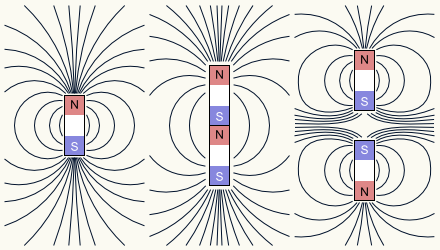
Experiments with sawdust have taught a lot. For example, a piece of iron approaches the pole of a magnet. If at the same time the paper on which the sawdust lies is shaken a little, the sawdust pattern begins to change. The magnetic lines become as if visible. They pass from the pole of the magnet to the piece of iron and become thicker as the iron approaches the pole. At the same time, the force with which the magnet pulls the piece of iron towards itself also increases.
At which end of the iron rod of the electromagnet is the north pole formed when a current passes through the coil, and at which is the south pole? It is easy to determine by the direction of the electric current in the coil. Current (flow of negative charges) is known to flow from the negative pole of the source to the positive.
Knowing this and looking at the coil of the electromagnet, one can imagine in which direction the current will flow in the turns of the electromagnet. At the end of the electromagnet, where the current will make a circular motion in the clockwise direction, a north pole is formed, and at the other end of the strip, where the current moves in a counter-clockwise direction, a south pole. If you change the direction of the current in the coil of the electromagnet, its poles will also change.
It was further observed that both the permanent magnet and the electromagnet attract much more strongly if they are not in the form of a straight bar, but are bent so that their opposite poles are close together.In this case, not one pole attracts, but two, and besides, the magnetic force lines are less scattered in space — they are concentrated between the poles.
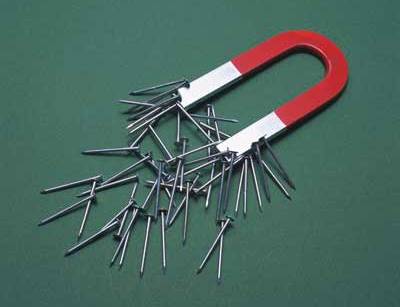
When the attracted iron object adheres to both poles, the horseshoe magnet almost stops dissipating lines of force into space. This is easy to see with the same sawdust on paper. The magnetic lines of force, which formerly extended from one pole to the other, now pass through the attracted iron object, as if it were easier for them to pass through iron than through air.
Research shows that this is indeed the case. A new concept has emerged — magnetic permeability, which denotes a value that indicates how many times it is easier for magnetic lines to pass through any substance than through air. Iron and some of its alloys have the highest magnetic permeability. This explains why, of the metals, iron is most attracted to a magnet.
Another metal, nickel, was found to have lower magnetic permeability. And is less attracted to a magnet. Certain other substances have been found to have a magnetic permeability greater than air and are therefore attracted to magnets.
But the magnetic properties of these substances are very weakly expressed. Therefore, all electrical devices and machines, in which electromagnets work in one way or another, to this day cannot do without iron or without special alloys that include iron.
Naturally, much attention has been paid to the study of iron and its magnetic properties almost from the very beginning of electrical engineering.True, strictly scientific calculations in this area became possible only after the studies of the Russian scientist Alexander Grigorievich Stoletov, conducted in 1872. He discovered that the magnetic permeability of each piece of iron is not constant. She is changing for the degree of magnetization of this piece.
The method of testing the magnetic properties of iron proposed by Stoletov has great value and is used by scientists and engineers in our time. A deeper study of the nature of magnetic phenomena became possible only after the development of the theory of the structure of matter.
The modern understanding of magnetism
We now know that every chemical element is made up of atoms — unusually small complex particles. At the center of the atom is a nucleus charged with positive electricity. Electrons, particles that carry a negative electrical charge, revolve around it. The number of electrons is not the same for the atoms of different chemical elements. For example, a hydrogen atom has only one electron orbiting its nucleus, while a uranium atom has ninety-two.
By carefully observing various electrical phenomena, scientists came to the conclusion that the electric current in a wire is nothing more than the movement of electrons. Now remember that a magnetic field always arises around a wire in which an electric current flows, that is, electrons move.
It follows that a magnetic field always appears where there is motion of electrons, in other words, the existence of a magnetic field is a consequence of the motion of electrons.
The question arises: in any substance, electrons are constantly rotating around their atomic nuclei, why in this case does not each substance form a magnetic field around itself?
Modern science gives the following answer to this. Each electron has more than just an electrical charge. It also has the properties of a magnet, it is a small elemental magnet. Thus, the magnetic field created by the electrons as they move around the nucleus is added to their own magnetic field.
In this case, the magnetic fields of most atoms, folding, are completely destroyed, absorbed. And in only a few atoms—iron, nickel, cobalt, and to a much lesser extent in others—the magnetic fields turn out to be unbalanced, and the atoms are small magnets. These substances are called ferromagnetic ("Ferrum" means iron).
If the atoms of ferromagnetic substances are arranged randomly, then the magnetic fields of different atoms directed in different directions eventually cancel each other out. But if you rotate them so that the magnetic fields add up—and that's what we do in magnetization—the magnetic fields will no longer cancel out, but add up to each other.
The whole body (a piece of iron) will create a magnetic field around itself, it will become a magnet. Similarly, when electrons move in one direction, which for example occurs with an electric current in a wire, the magnetic field of the individual electrons adds to a total magnetic field.
In turn, electrons trapped in an external magnetic field are always exposed to the latter. This allows the movement of electrons to be controlled using a magnetic field.
All of the above is only an approximate and very simplified scheme. In reality, the atomic phenomena that occur in wires and magnetic materials are more complex.
The science of magnets and magnetic phenomena — magnetology — is very important to modern electrical engineering.A great contribution to the development of this science was made by the magnetologist Nikolay Sergeevich Akulov, who discovered an important law known throughout the world as "Akulov's law". This law makes it possible to determine in advance how such important properties of metals as electrical conductivity, thermal conductivity, etc., change during magnetization.
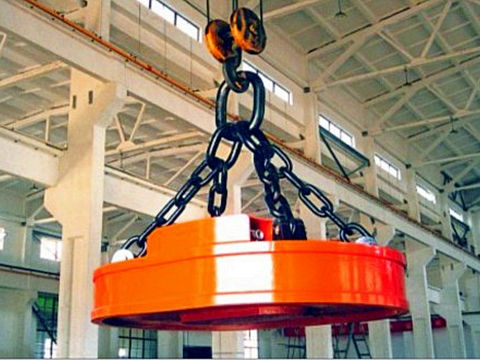
Generations of scientists have worked to penetrate the mystery of magnetic phenomena and put these phenomena at the service of humanity. Today, millions of the most diverse magnets and electromagnets work for the benefit of man in various electrical machines and devices. They free people from hard physical labor, and sometimes they are indispensable servants.
Check out other interesting and useful articles about magnets and their applications:
Magnetism and Electromagnetism
Permanent magnets — types, properties, interaction of magnets
The use of permanent magnets in electrical engineering and energy

